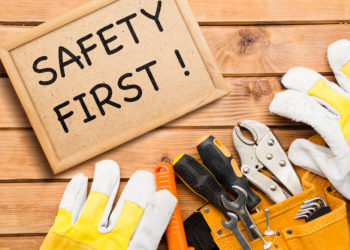As much as you’d want it to be, being a landlord isn’t just collecting rent once a month. This ‘role’ brings with it serious legal and moral responsibilities.
Fire safety is at the top of that list, especially in high-risk zones like Birmingham and Smethwick where older buildings and Houses in Multiple Occupation, or HMOs, are common.
UK law, very plainly, demands that the landlords make sure that their properties meet the fire safety standards set by the authorities.
Failure to do so will not be looked at kindly, and will bring all sorts of trouble from the authorities including fines, closure of business, denial of insurance. It will also cause loss of lives, and damage to assets and property.
Whether you’re managing a single flat or multiple properties, staying compliant with fire safety for landlords isn’t optional, it’s essential.
Let’s go through five most common fire safety mistakes landlords make and exactly how to avoid them before it’s too late.
Mistake 1: Not Conducting Regular Fire Risk Assessments
The Mistake
A lot of landlords are guilty of this error, where they simply ‘neglect’ (either knowingly or willingly) to carry out a fire risk assessment of their building. Many of them assume, very mistakenly, that doing an FRA once will be enough.
Well, it is not.
You see, properties evolve, tenants move in, layouts change, and equipment ages and becomes old. All of these things can bring new fire risks into the mix, and change the nature of previous ones.
The Fallout
Landlords taking a hike on this responsibility will not only be risking the well-being of their tenants, but will also be facing some tough penalties from the authorities.
In case of a fire, lack of a current assessment could void your insurance and lead to prosecution.
How to Avoid It
Carry out a professional fire risk assessment Birmingham or wherever your property is located at least annually, or more often if it’s a HMO.
This is especially vital for properties in Smethwick, where local councils are strict on compliance.
Qualified assessors can spot risks you may never notice while conducting a professional fire risk assessment and provide reports that satisfy legal obligations.
Mistake 2: Poorly Maintained Smoke and Fire Alarms
The Mistake
Having alarms installed is not enough. Many landlords fail to test, replace, or maintain fire alarms, leaving tenants dangerously exposed.
The Consequences
Letting alarms fall into disrepair breaches your landlord fire safety responsibilities, and the consequences can be fatal, not just legally, but in lives lost due to unalerted fires.
How to Avoid It
Test alarms every month, and record each test. Make sure smoke alarms are installed in all habitable rooms and that heat detectors are used in kitchens.
For large or multiple properties, smart alarm systems offer monitoring and logs, making compliance easier.
Staying on top of alarm maintenance shows tenants you take fire safety for landlords seriously.
Mistake 3: Ignoring Fire Doors or Blocked Fire Exits
The Mistake
Fire doors and exits are a legal necessity, yet many landlords allow them to be blocked or propped open, especially in communal areas of HMOs.
The Fallout
A damaged fire door or obstructed exit violates HMO fire regulations UK and could mean tenants are unable to evacuate safely.
The penalties? Legal action, revoked licenses, and even closure notices from local authorities.
How to Avoid It
Check your fire doors every month to make sure that they shut automatically and seal in the correct way. Never allow tenants to wedge them open.
Make fire escape routes a key part of every property inspection. In dense residential areas like Smethwick and Birmingham, blocked exits can be grounds for fines during surprise inspections.
Mistake 4: Lack of Fire Safety Documentation for Tenants
The Mistake
Another overlooked issue is failing to provide tenants with clear fire safety documentation. Tenants who aren’t informed may unknowingly put themselves, and the property, at risk.
The Fallout
Not issuing information packs, evacuation routes, or alarm test logs is a clear violation of landlord fire safety responsibilities under UK law, meaning you’ll be committing a crime by not doing it.
How to Avoid It
Supply tenants with a welcome pack that includes your fire risk assessment, escape plans, contact details, and alarm test schedules.
Keep digital logs and update them regularly. Whether you’re in a single flat or managing several properties across Birmingham, this simple step helps you remain compliant and protects tenants’ safety.
Mistake 5: Failing to Train Tenants or Staff on Basic Fire Protocols
The Mistake
Some landlords wrongly assume tenants will figure out the ‘perfect’ response themselves during a fire.
This is not how it happens in emergencies.
Panic and confusion are guaranteed if people aren’t properly trained or informed.
The Fallout
Landlords who ignore fire drills or safety briefings are neglecting a crucial part of fire safety for landlords, especially in HMOs and multi-tenant buildings.
How to Avoid It

Organize annual fire drills or briefings during move-in. Provide visual guides in communal areas. Letting agents / managers of properties operating in the Birmingham and Smethwick real estate sector should receive proper training in evacuation protocols.
Better yet, your local UK fire risk assessment provider may offer optional training as part of their services.
Conclusion
The UK law takes fire safety very seriously, and expects landlords to think the same way about it.
As a landlord, you hold the power and the responsibility to ensure your property is as safe as it can be. Complacency is costly.
If you’re managing properties in Smethwick or Birmingham, don’t risk being caught off guard. You’ll need professional assistance to avoid that.
The fire safety risk assessment experts (This team is here to support you with thorough, professional fire safety inspections tailored to your property’s needs) will be able to identify your blind spots and help you stay compliant with HMO fire regulations UK.











































































